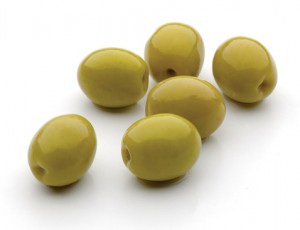https://cdn.steemitimages.com/DQmZ86X1uRHjBPgPWbPShZ7m2gBgi2dKZGYvg7QFpoJmhU6/aceitunasSERPIS1-300x230.jpg
[source](https://www.google.com/url?sa=i&source=images&cd=&ved=&url=https%3A%2F%2Fwww.aceitunasrellenasdeanchoa.com%2Fcategory%2Fbeneficiosaceitunas%2F&psig=AOvVaw3zkC0UzOCsNs8DOqIb2UOQ&ust=1561727421583005)

Olives (olives) - a subtropical evergreen tree of the genus Olive (Olea), of the Olive family (Oleaceae). The height of an adult olive tree cultivated is usually five to six meters, but sometimes reaches 10 to 11 meters or more. The trunk is covered with gray, blunt, twisted bark, generally hollow in old age. The branches are knotted, long. The leaves are narrow-lanceolate, gray-green, do not fall during the winter and gradually resume for a period of two to three years. The fragrant flowers are very small, 2 to 4 centimeters long, whitish, in an inflorescence of 10 to 40 flowers. Fruit - oval elongated olives with a length of 0.7 to 4 centimeters and a diameter of 1 to 2 centimeters, with a pointed or blunt nose, fleshy, containing nut in the nut. The color of the pulp of the fruit, depending on the type of tree, can be green, black or dark purple with a layer of intense wax. The stone is very dense, with a grooved surface. The ripening of the fruit occurs 4-5 months after flowering. It blooms from the end of April to the beginning of July. Productive olive tree from 20 years old. The tree has the effect of alternating and fruiting every 2 years. Since ancient times, the plant has been cultivated to produce olive oil, it is not found in the wild. The olive is the cradle of the Mediterranean. The olive tree lives up to two thousand years, very resistant, undemanding for the soil. Olive trees are grown in Greece, Spain, Italy, in the countries of North Africa, in the southeastern United States, in the Crimea, Transcaucasus and Azerbaijan. The olive tree has been cultivated in Azerbaijan for a long time. This is confirmed by the remains of this plant found during the excavations of Absheron, Barda and other areas. Unfortunately, the olive plantations of Azerbaijan were cut and burned by numerous invaders, especially during the invasion of the Mongols. Currently, one of the oldest trees is preserved in the villages. Nardaran (Baku), which is at least 180-200 years old. Artificial black olives can be distinguished from mature ones without opening the jar. In its composition there is always iron gluconate (additive E 579): it is a chemical to fix the black color, without which the olives will turn pale. Such olives are very black and often even bright. This is an unnatural color. The fruits of the olive trees contain a large amount of high quality vegetable fats and, therefore, have a high nutritional and energetic value. In the raw pulp, the olives contain proteins (6%), fiber (9%), water (23%), pectin substances, fats or oil (56%), sugar, vitamins B, C, carotene, potassium, calcium , glycosides, ash. substances The substances contained in olives strengthen cell membranes and mucous membranes, and have a beneficial effect on the functioning of the stomach, pancreas, liver and cardiovascular system. It helps with healing wounds, cleanses the body of toxins and toxins. The olives help strengthen the bone tissues, improve the functioning of the liver. Nutritionists believe that eating black olives, in which less salt, prevents the development of gastric ulcers. And 20 olives, consumed per month, are an excellent prevention of deposits of calculus and formation of stones in various organs (bile ducts, gall bladder, kidneys). The most useful oil (although with an unusual aroma) is considered the oil of the first cold pressing. The monounsaturated fatty acids (stearic, oleic, palmitic) contained in the oil can reduce cholesterol levels and delay the aging process. It is not surprising the olives and olive oil, one of the main elements of the Mediterranean diet. According to the researchers, the combination of antioxidants and healthy fats makes olive oil a means to prevent the development of breast cancer, intestinal tumors and skin. The use of olive oil improves the functioning of the biliary tract, eliminates constipation, restores the gastric mucosa. Canned olives also contain oil, which means they have a beneficial effect on our body. Olive oil can successfully lubricate burns, abrasions, bruises and insect bites. And, of course, use in cosmetics for the home: a mask of a mixture of egg yolk and 70 g of oil tones, tense and refreshes the skin. An infusion of olive leaves decreases blood pressure. Ace olives have practically no contraindications. However, olive oil should not be used for cholecystitis, since it has a choleretic effect; In addition, people suffering from obesity, it is necessary to use it in moderation due to its high caloric content. Also, be careful with olives, the so-called black olives, which are in fact blackened olives treated with a special solution. Such a product can be harmful to the body.

Originally posted here: https://steemit.com/naturalmedicine/@malenagarcia/olives-and-their-benefits


No comments:
Post a Comment